Indian Premier League (IPL)
(→The 2017 auctions) |
(→2017/ IPL- 10) |
||
| Line 278: | Line 278: | ||
[[File: The highlights of IPL- 10, 2017.jpg| The highlights of IPL- 10, 2017 ; [http://epaperbeta.timesofindia.com/Gallery.aspx?id=22_05_2017_001_059_002&type=P&artUrl=MUMBAI-PULL-OFF-SUPER-WIN-LIFT-IPL-TROPHY-22052017001059&eid=31808 The Times of India], May 22, 2017|frame|500px]] | [[File: The highlights of IPL- 10, 2017.jpg| The highlights of IPL- 10, 2017 ; [http://epaperbeta.timesofindia.com/Gallery.aspx?id=22_05_2017_001_059_002&type=P&artUrl=MUMBAI-PULL-OFF-SUPER-WIN-LIFT-IPL-TROPHY-22052017001059&eid=31808 The Times of India], May 22, 2017|frame|500px]] | ||
| + | |||
| + | ==Did high player salaries result in success?== | ||
| + | [http://epaperbeta.timesofindia.com/Article.aspx?eid=31808&articlexml=MONEY-ALONE-CANT-WIN-YOU-GAMES-23052017019017 Manuja Veerappa, May 23, 2017: The Times of India] | ||
| + | |||
| + | '''See graphic''' | ||
| + | |||
| + | [[File:Crorepatis, how they fared, IPL-10, 2017.jpg|Crorepatis, how they fared, IPL-10, 2017; [http://epaperbeta.timesofindia.com/Article.aspx?eid=31808&articlexml=MONEY-ALONE-CANT-WIN-YOU-GAMES-23052017019017 The Times of India], May 23, 2017, Manuja Veerappa|frame|500px]] | ||
| + | |||
| + | '''IPL-10: Some Investments Went Down The Drain Although A Few Teams Used Their Big Buys Well''' | ||
| + | |||
| + | If Tymal Mills' IPL performance is measured by his bid price, then each of the five wickets he claimed for Royal Challengers Bangalore came with a mindboggling tag of Rs 2.40 crore! The England pacer, who at Rs 12 crore was the second costliest player at IPL-10, did not do anything extraordinary in the five appearances he made for his franchise. | ||
| + | |||
| + | A T20 specialist, Mills was among the 21 players who hit pay dirt after being picked for a crore or more at the auction held in February . While Ben Stokes (Rising Pune Supergiant) was the costliest at Rs 14.5 crore, others like M Ashwin (Delhi Daredevils), Dan Christian (Rising Pune Supergiant) and Pawan Negi (RCB) earned Rs 1 crore each at the auction.While a few justified their price tags, some disappointed, while the others returned home after being benched through the season. | ||
| + | |||
| + | Stokes and Christian were Pune's main picks at the auction and wise ones at that.Stokes was at the heart of Pune's campaign in the 12 matches he played before joining the England team. Electric and quick as a fielder, the all-rounder claimed 12 wickets at an average of 26.33 and scored 316 runs including an unbeaten century (103 n.o.). His presence in the Pune dressing room turned out to be invaluable for the team. Likewise, Christian with 11 wickets from 13 matches didn't do badly either. | ||
| + | |||
| + | Apart from Pune, the teams for whom investment in crorepati players turned out to be profitable were Kolkata Knight Riders, Mumbai Indians and Sunrisers Hyderabad. | ||
| + | |||
| + | The pace trio of Trent Boult (Rs 5cr), Chris Woakes (Rs 4.2cr) and Nathan Coulter-Nile (Rs 3.5cr) was Kolkata's top buys of the season.While Boult wasn't in peak form, Woakes turned out to be the bowling trump card for Kolkata, picking up 17 wickets in 13 matches.Coulter-Nile too fared well with 15 wickets from eight outings including his three-for in the Eliminator against Hyderabad. | ||
| + | |||
| + | Afghan spinner Rashid Khan and pacer M Siraj didn't disappoint Hyderabad. A Rs 2-crore investment in veteran Aussie pacer Mitchell Johnson proved to be a game-changer for Mumbai, who were also rewarded for their faith in Karn Sharma (Rs 3.2cr), who saw them through to the final with his tidy bowling. In contrast, Karnataka's spin bowler K Gowtham, who created a buzz after attracting a Rs 2-crore bid, didn't get to play even a game for Mumbai. | ||
Revision as of 15:29, 28 June 2017
This is a collection of articles archived for the excellence of their content. |
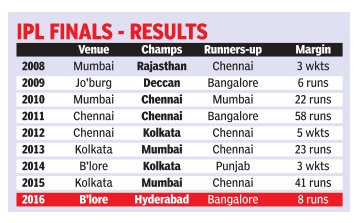
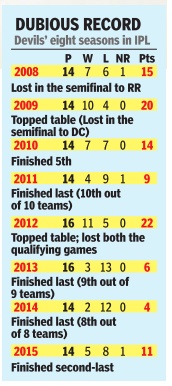
Contents |
Introduction
Established in 2008
The Times of India, April 8, 2016
Twenty20 cricket became phenomenally popular after India won the inaugural World Twenty20 title in 2007 under the captaincy of Mahendra Singh Dhoni. The victory not only rejuvenated the Indians fans, who were reeling under the disappointment of the 2007 ODI World Cup, but it also gave way to the conceptualization of the Indian Premier League that has since then not only cashed on the craze but has also changed the way cricket is played in India.
Brain child of the then BCCI vice-president Lalit Modi, the IPL was launched in 2008 with much fanfare as a competitive response to the Indian Cricket League (ICL) that was not recognized by the BCCI. Since then the IPL has not only come out as the clear victor but has given birth to various T20 leagues around the world and is the most-attended cricket league in the world. The ICL, with controversies of non-payment and fixing, folded up in 2009.
Following the same format as that of English Premier League (EPL) and the National Basketball Association (NBA), the IPL works on a franchise system that were put for auction, where the highest bidder won the rights to own the team, representing each city.
2008: the beginnings
K ShriniwasRao, Apr 05 2017: The Times of India
A Decade After It Set The Benchmark For T20 Leagues, Is The IPL Still Blazing The Trail When It Comes To Innovation? Ten years ago, on a pleasant afternoon in 2008, when a five-star hotel in the south of Mumbai played host to an Indian Premier League (IPL) player auction, the first of its kind in any sport across the world, Sotheby's London auction house was yet to make a killing from a fascinating bronze sculpture -a Swiss masterpiece -waiting to go under the hammer. The winning bid for Walking Man I didn't quite proverbially match up to the cheque written (and the noise made) for Mahendra Singh Dhoni, the scale of contemporary European art notwithstanding. Much later, Richard Madley , the competent London-based auctioneer at IPL for a decade now, would admit -a bit in disbelief and a lot in awe -that sport, much defined like art as an expression of human creative skill, had taken a multi-dimensional leap of faith that astonishing afternoon. Cricket, until then a sport that had been looking to readdress itself in ways that could reassure coming generations of its viability, was given a new life by administrators with twisted hearts and professionals with incredible designs.
This was 2008. India hadn't yet woken up to the idea of leagues until then. By that time, NFL the celebrated American football league was already 88 years old and the NBA the premier men's basketball tournament 62. It was pure innovation at play for IPL, working at multiple levels that helped redraft cricketing philosophies in ways that made the world sit up and take note. Never before had an investor in sport become a bigger talking point than the investment itself.
The results of the finals
2008-16: See graphic.
Impact on cricket in India
The Times of India, April 8, 2016
The first IPL auction took place on January 24, 2008 and the total base price for the auction was $400 million. The auction went on to fetch $723.59 million.
The Mumbai franchise (Mumbai Indians) owned by Mukesh Ambani's Reliance Industries Limited (RIL) was the most expensive franchise - fetching $111.9 million closely followed by Vijay Mallya's United Breweries which paid $111.6 million for the Bangalore franchise (Royal Challengers Bangalore). Media house Deccan Chronicle won the Hyderabad franchise (Deccan Chargers) for $107 million, while India Cements' Chennai franchise (Chennai Super Kings) cost $91 million.
Shah Rukh Khan and Juhi Chawla's Red Chillies Entertainment bought the Kolkata franchise (Kolkata Knight Riders) for $75.09, while Preity Zinta and her then beau Ness Wadia bought the Mohali team (Kings XI Punjab) for $76 million. Infrastructure development group GMR bagged the ownership of the Delhi team (Delhi Daredevils) for $84 million and the Emerging Media, consisting of its CEO Fraser Castellino, Manoj Badale and Lachlan Murdoch and other investors won the rights for the Jaipur franchise (Rajasthan Royals) for $67 million.
The maiden edition of IPL had eight teams comprising a minimum of 16 players each. The tournament lasted for 44 days and involved 59 matches. And since then the league has had its share of controversies and seen many ups and down. Two new leagues - Pune Warriors India (bought by the Sahara group for $370 million) and Kochi Tuskers Kerala (purchased by Rendezvous Sports World for $333.3 million) - were brought in before the fourth season of the league in 2011. But the Kochi Tuskers were soon terminated for breaching the BCCI's terms and conditions.
2009 champions Deccan Chargers were suspended in 2012 and then renamed Sunrisers Hyderabad under new owners Sun TV Network. But the biggest shock came in 2013 when the IPL was rocked by the fixing and betting scandal and many big names got embroiled in the controversy and it resulted in not only a few heads being rolled but entire teams were suspended. After two years of trials and tribulations, two-time champions Chennai Super Kings and the inaugural champions Rajasthan Royals were suspended for two seasons.
Rajasthan Royals players S Sreesanth, Ajit Chandila and Ankeet Chavan were arrested by Delhi police in Mumbai on charges of spot-fixing during IPL 6. Sreesanth and Chavan were subsequently banned for life by the BCCI's disciplinary committee.
Gujarat Lions and Rising Pune Supergiants replaced Chennai Super Kings and Rajasthan Royals for two seasons. Dhoni and his longtime Chennai Super Kings teammate Suresh Raina were picked to play for opposing teams in the first-ever player draft of the IPL that was held in Mumbai on December 15, 2015.
Rising Pune Supergiants, the Pune franchise bought by Kolkata-based businessman Sanjiv Goenka, expectedly picked Dhoni as the first player for Rs 12.5 crore and Intex Technologies owner Keshav Bansal, who invested in Gujarat Lions, picked Raina as the first choice followed by Ravindra Jadeja - the local Saurashtra boy who has grown up playing in Rajkot.
The two new franchises paid Rs 12.5 crore to the first player they picked at the draft, Rs 9.5 crore to the second, Rs 7.5 crore to the third, Rs 5.5 crore to the fourth and Rs 4 crore to the fifth. The two franchises had a limited purse of Rs 66 crore to form their squads for the season and a minimum spending of Rs 40 crore was mandatory between the draft and the auction in February. Australian all-rounder Shane Watson emerged as the biggest draw going for a whopping Rs 9.50 crore bought by Royal Challengers Bangalore but it was Pawan Negi who turned heads with a mind-boggling deal of Rs 8.50 crore by Delhi Daredevils to be the costliest Indian buy in the 2016 IPL players' auction.
With corporate megabucks, Bollywood glamour and the frequent sound of wood thumping leather, the IPL has revolutionized the sport in the way it was played and cricketainment has been the new word to describe the evolution of a new chapter in history of cricket. The Indian Premier League has proved that cricket will never be the same again.
Records
2008-16, some 2017: See graphic.
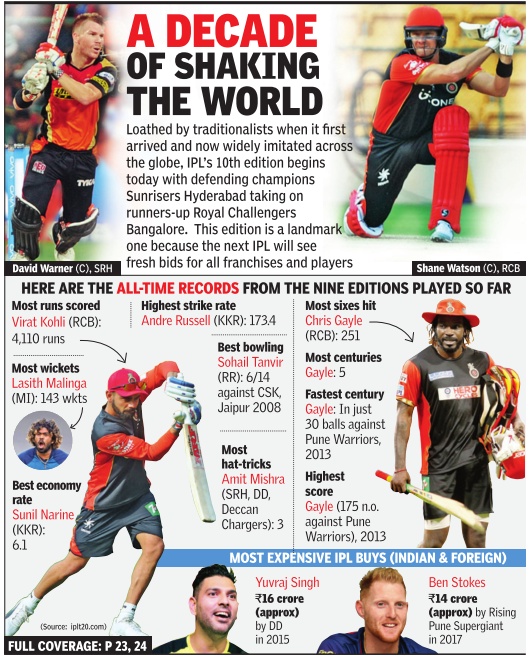
Indian Premier League: The economics of
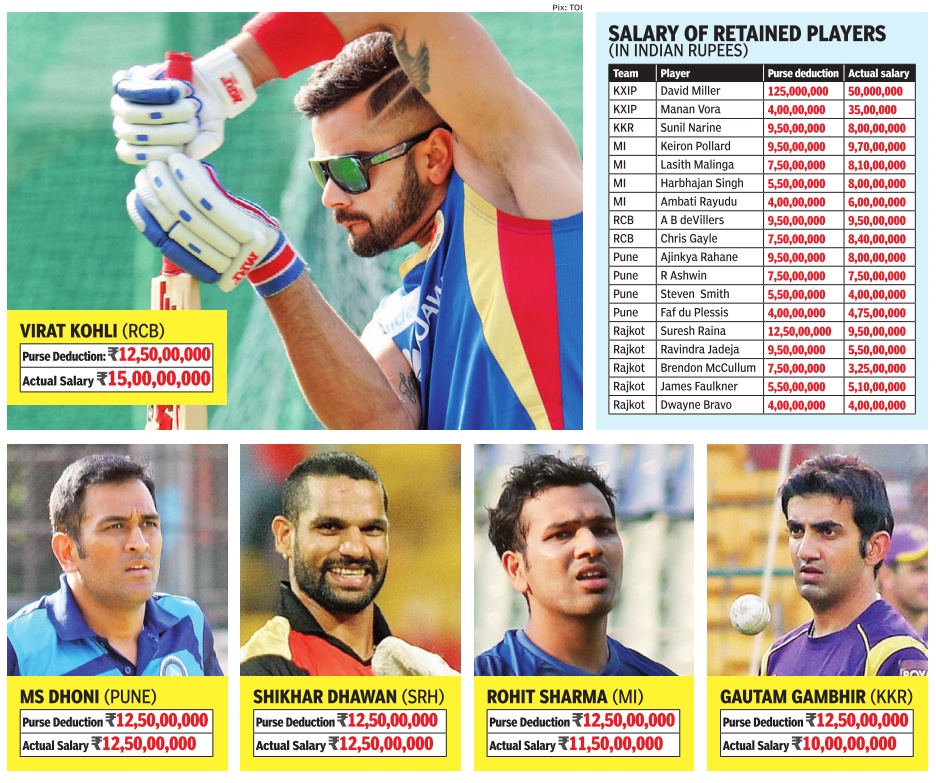
Advertising revenues
Multi Screen Media (MSM), the official broadcaster of Indian Premier League (IPL) has brought on board a total of eight sponsors for the sixth edition of the Twenty20 tournament, which would help it rake in Rs 200 crore more over last year, after lowering its ad rates by 10-15%. Three more sponsors are expected to join over the next two weeks.
The presenting sponsors — PepsiCo and Vodafone — have shelled out around Rs 40-60 crore each while the associate sponsors, which include Tata Photon, Karbonn tablets, Godrej, Samsung Mobiles, Panasonic and Usha Appliances, have paid around Rs 25-30 crore each for being seen on the channel during the tournament.
MSM is looking to earn Rs 950 crore as advertising revenue from IPL-6, up 27% from Rs 750 crore it garnered last year, a senior executive from the company told TOI.
This will be the first time that the IPL will have three feeds — the regular one on SET max, while Sony Six will broadcast a Hindi feed along with an HD one.
Some of the other sponsors likely to be signed on soon for the tournament, which starts on April 3, are Cadbury and Havells — both have had a long-term association with the IPL. This year, MSM has two presenting sponsors and is expected to close nine associate sponsors, up from only five which it managed last year. The channel has also struck large deals with Coca-Cola, Parle Agro, Marico, Berger Paints and Airtel, besides others, filling 70% of its inventory.
“Last year, we had increased the ad rates but could not sell the entire inventory. Our strategy to reduce rates has worked very well and we have seen the interest levels go up. Advertisers from all sectors are on board this year, signaling a revival in sentiments,” said Rohit Gupta, president, MSM.
During 2012, a 10-second ad spot during the IPL had a price tag of Rs 4.5-5.5 lakh, making it a highly premium property. However, reduction in rates has made it far more affordable, said media planners who buy TV airtime for advertisers. “If TV ratings had to fall, it had to fall last year. Now they have stabilized. It is definitely value for money at this rate and with lesser risk,” said Ajit Varghese, MD (South Asia), Maxus, which has bought airtime for telecom major Vodafone.
The IPL reached 170 million eyeballs and clocked an average rating of around 3.27 last year, according to TAM Media Research. MSM’s Gupta said he is expecting the reach to further grow this season. “If there is a big product launch or a new ad campaign, this is a large platform which is a must for any brand. It is a property which is targeted at male audiences, so it works well for brands which directly communicate with this audience group,” said Basabdutta Chowdhury, CEO of Platinum Media, a division of media buying group Madison. This year, soft drink giants PepsiCo is the new title sponsor of the IPL, having paid Rs 396 crore for the next five seasons.
Music at the IPL
Singers demand unpaid royalty, ban
The Times of India, Apr 10 2016
HC bans film songs in IPL
The Delhi High Court has restrained IPL organisers from playing Hindi film songs during the ongoing T20 league. The order came on a plea moved by the Indian Singers Rights Association (ISRA) which has sought an injunction against the IPL teams, excluding Delhi Daredevils, by asserting that playing of songs without the nod of members of the body amounts to infringement of “performer's rights“.
The court asked event management firm -DNA Entertainment Networks Pvt Ltd -to refrain from playing the songs till April 19. The lawsuit filed on behalf of ISRA, whose members include LataMangeshkar, AlkaYagnik, Asha Bhosle and Kailash Kher, alleged that till date, neither IPL teams nor the event management firm has paid royalty for the previous years and not obtained permission from it for playing of songs of its members in this year's IPL matches.
Controversies: 2008-16
The Times of India, December 3, 2016
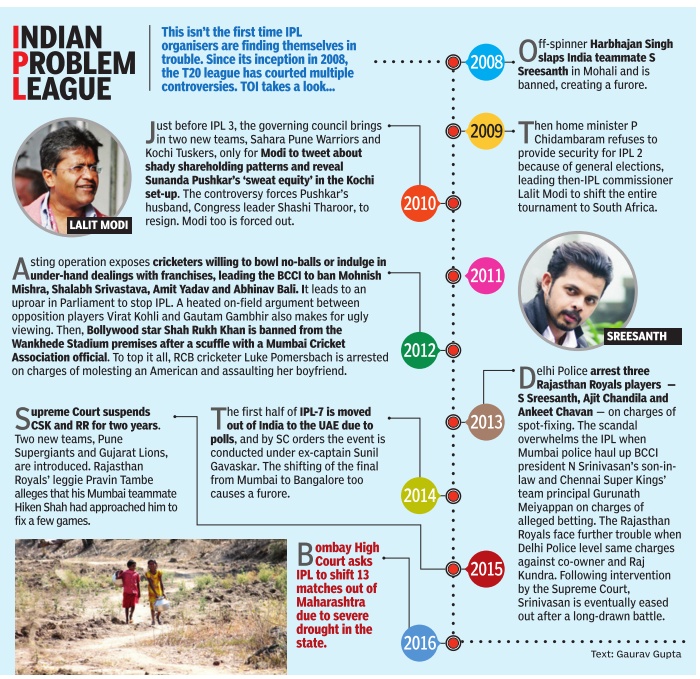
1. 2016: Maharashtra asked to shift IPL matches
Bombay High Court asks IPL to shift 13 matches out of Maharashtra due to severe drought in the state.
2. 2015: CSK and RR suspended
Supreme Court suspends CSK and RR for two years. Two new teams, Pune Supergiants and Gujarat Lions, are introduced. Rajasthan Royals’ leggie Pravin Tambe alleges that his Mumbai teammate Hiken Shah had approached him to fix a few games.
3. 2014: IPL 7 conducted under Gavaskar’s supervision
The first half of IPL-7 is moved out of India to the UAE due to polls, and by SC orders the event is conducted under ex-captain Sunil Gavaskar. The shifting of the final from Mumbai to Bangalore too causes a furore.
4. 2013: Betting allegations hit CSK & RR
Delhi Police arrest three Rajasthan Royals players — S Sreesanth, Ajit Chandila and Ankeet Chavan — on charges of spot-fixing. The scandal overwhelms the IPL when Mumbai police haul up BCCI president N Srinivasan’s son-in-law and Chennai Super Kings’ team principal Gurunath Meiyappan on charges of alleged betting. The Rajasthan Royals face further trouble when Delhi Police level same charges against co-owner and Raj Kundra. Following intervention by the Supreme Court, Srinivasan is eventually eased out after a long-drawn battle.
5. 2012: Shah Rukh Khan banned from Wankhede Stadium premises
A sting operation exposes cricketers willing to bowl no-balls or indulge in under-hand dealings with franchises, leading the BCCI to ban Mohnish Mishra, Shalabh Srivastava, Amit Yadav and Abhinav Bali. I t leads to an uproar in Parliament to stop IPL. A heated on-field argument between opposition players Virat Kohli and Gautam Gambhir also makes for ugly viewing. Then, Bollywood star Shah Rukh Khan is banned from the Wankhede Stadium premises after a scuffle with a Mumbai Cricket Association official. To top it all, RCB cricketer Luke Pomersbach is arrested on charges of molesting an American and assaulting her boyfriend.
6. 2010: Sunanda Pushkar’s ‘sweat equity’ in Kochi
Just before IPL 3, the governing council brings in two new teams, Sahara Pune Warriors and Kochi Tuskers, only for Modi to tweet about shady shareholding patterns and reveal Sunanda Pushkar’s ‘sweat equity’ in the Kochi set-up. The controversy forces Pushkar’s husband, Congress leader Shashi Tharoor, to resign. Modi too is forced out.
7. 2009: IPL 2 shifted to South Africa
Then home minister P Chidambaram refuses to provide security for IPL 2 because of general elections, leading then-IPL commissioner Lalit Modi to shift the entire tournament to South Africa.
8. 2008: Harbhajan slaps Sreesanth.
Off-spinner Harbhajan Singh slaps India teammate S Sreesanth in Mohali and is banned, creating a furore.
Spot fixing case: 2013
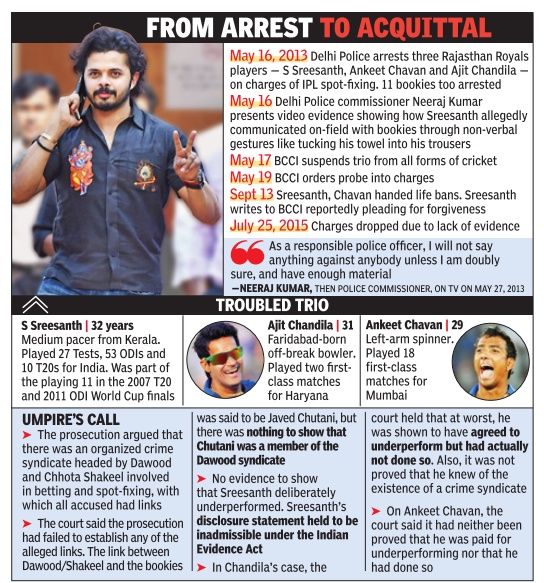

2013-14
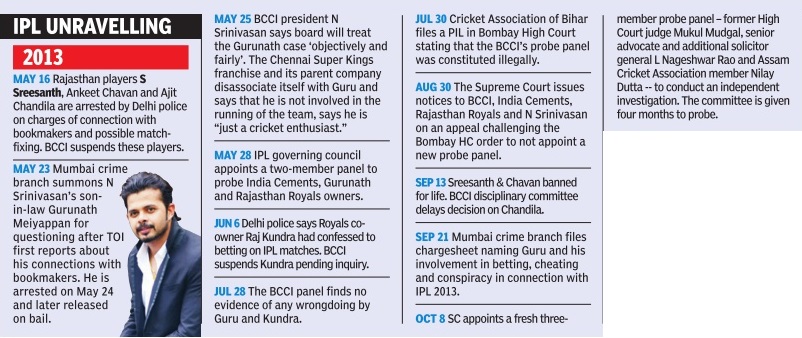
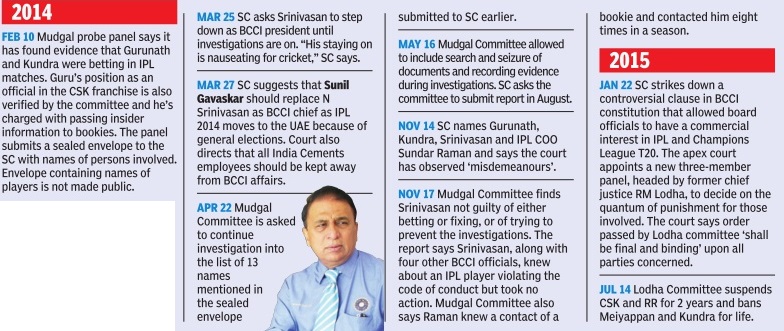
The IPL numbers
IPL broadcast rights
In 2008, the consortium of India's Sony Television network and the Singaporebased World Sports Group (WSG) had secured the rights of the IPL for ten years at a cost of more than $1 billion.As part of the deal, the consortium would pay the BCCI $908 million for the telecast rights and $108 million for the promotion of the tournament. However, in a reworked deal next year, BCCI signed a new deal with MSMPL (Multi Screen Media Pvt Ltd) and World Sport Group (WSG) for Rs 8,200 crore with 80% of the amount to come from MSMPL. Later WSG exited the deal after a one-time payoff.
IPL title rights
DLF had bought the title rights of the IPL for five years in 2008 for Rs 200 crore.In 2013, Pepsi bid for the rights for the next five years and won it at Rs 396 crore.
IPL business model
IPL runs on a Central and Local pool of sponsorships for revenues. Broadcasters, tournament sponsors, title rights holders and bid monies form the central pool. Gate money, in-stadia advertising, franchise sponsors and merchandising make for the Local Pool. The Central Pool revenue is shared by all eight franchises on a percentage basis. The franchise has to fend for itself where Local Pool is concerned.
Future
The players from Royals and CSK franchise cannot be bought by or absorbed in any other franchise. Each team has a limit of 26 players and a fixed purse. For CSK and RR players to participate in IPL, the BCCI will have to float a tender for two fresh teams. There is no restriction if CSK and RR want to sell their franchises ahead of the coming season, after BCCI clearance. A full-fledged auction of all players is now scheduled after the 2016 edition of IPL.Both Royals and CSK have 26 players each and so do most other franchises. CSK has one-year contracts with most of its cricketers, who can go back into the auction pool but other franchises will have to off-load players to be able to buy them. With Kochi Tuskers winning their arbitration with BCCI, they're free to participate in IPL. Some players can be included in the Kochi franchise if they agree to play the tournament. However, one new franchise will still have to be auctioned. If Kochi Tuskers are unwilling to play, BCCI will have to auction two new franchises. IPL broadcast rights are up for a resale in 2017.
IPL jinxed for team owners?
The Times of India, Jul 17 2015
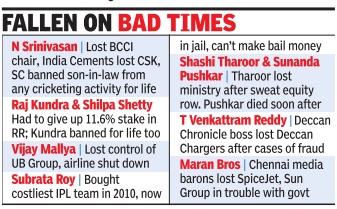
K ShriniwasRao
A leading Mumbai businessman, once interested in buying an Indian Premier League franchise today wants nothing to do with the glamorous cricket league. He believes IPL is bringing bad luck to team owners. Dramatic as it may sound, a quick look at where the owners have landed up post their IPL buys tends to lend credence to this expression of superstition. The businessman was insistent: “Vijay Mallya, Subrata Roy , Venkattram Reddy , the Maran brothers, even Lalit Modi -just look where they are.Isn't it eerie?“ As facts go, the businessman isn't off the mark. Subrata Roy is in jail, Reddy was ar rested, Mallya is in trouble with the authorities, Maranowned Sun TV is having prob lems with the home ministry over security clearances, Lalit Modi is wanted by ED, and Sunanda Pushkar is dead. Even love has gone missing from Ness Wadia and Pre ity Zinta's lives. And N Srinivasan has lost his prized BCCI president's chair.
Wait, not just Srinivasan.His son-in-law Gurunath Meiyappan, a mere cricket enthusiast according to his father-inlaw, has been pulled up by the Supreme Court for talking to bookmakers and banned for life from cricket. Ditto with another part owner, Raj Kundra of Rajasthan Royals.
Those who have bucked the trend are movie star Shah Rukh Khan, India's biggest businessman Mukesh Ambani and his wife Nita, and the Delhi franchisee GMR.
Heck, the league itself is now in massive trouble. The judgment delivered by the SC-appointed Justice Lodha committee has reduced the IPL to just six teams of which, again, some are in serious financial trouble.
T Venkattram Reddy, the strapping boss of Deccan Chronicle Holdings Ltd, from Hyderabad, lost his team Deccan Chargers after cases of financial fraud with several banks began surfacing post 2011.
And the owners who replaced the team in Hyderabad Maran Brothers of Sun TV are also struggling. Once the eyes and ears of former DMK chief M Karunanidhi, the Chennai media barons are no longer politically protected.Apart from the cloud over their TV channels, they have had to sell their airline SpiceJet back to the original promoter.
Is this the reason why Parth Jindal of Bangalore-based JSW Group doesn't want to get into the IPL?
2016
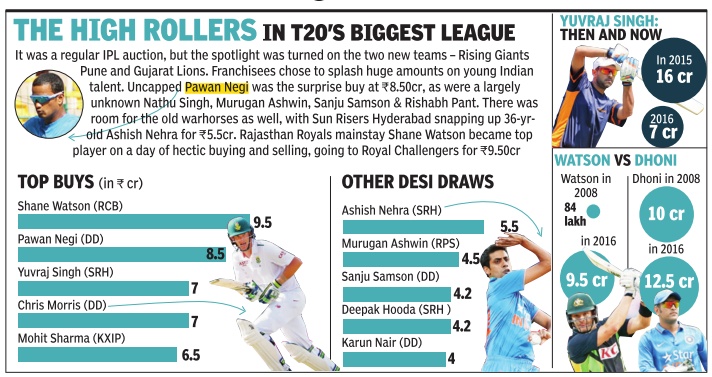

2017, Players retained and offloaded
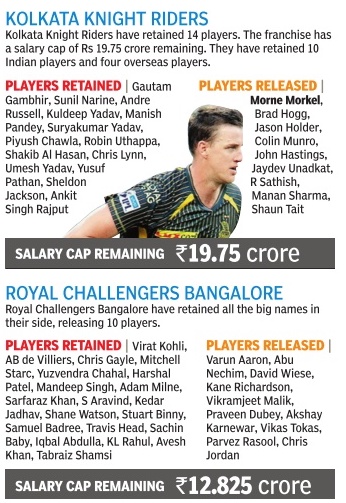
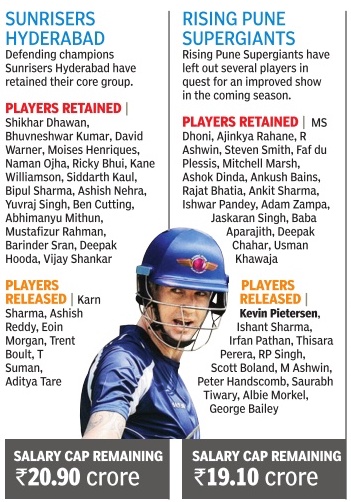
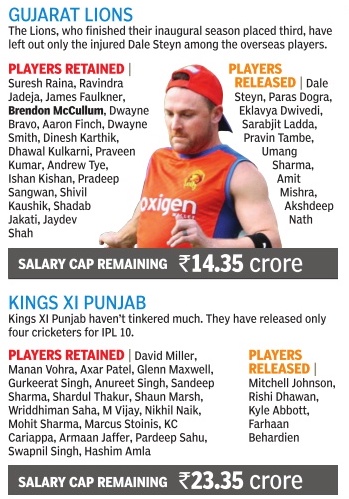

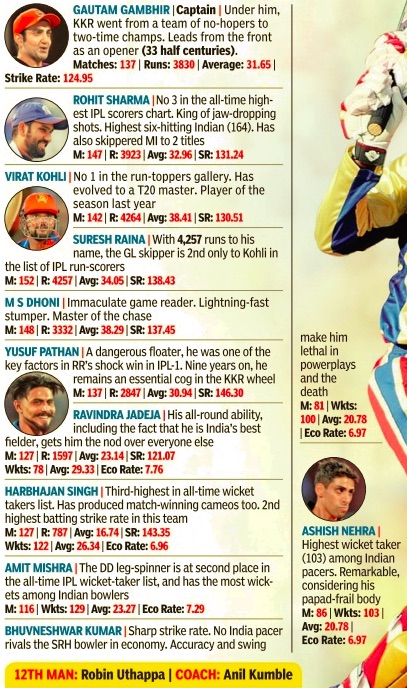


The 2017 auctions
Manuja Veerappa, Feb 21 2017: The Times of India
Stokes Sets League Record As Highest-Paid Foreign Player; Mills, Woakes Too Cash In
England's cricketers dominated proceedings and extracted the maximum from franchises as aspirants went under the hammer in the 10th edition of the IPL auction. Leading the pack was allrounder Ben Stokes, 25, who became the most expensive overseas IPL player when he was snapped up by Pune for Rs. 14.50 crore. Stokes' teammate Tymal Mills was the next big gainer at Rs 12 crore. Starting off at a base price of Rs 50 lakh, the left-arm pacer saw aggressive bidding from Kings XI Punjab, Mumbai Indians, Kolkata Knight Riders and Royal Challengers Bangalore. RCB, looking to fill the void left by Mitchell Starc, splurged on the 24-year-old, a T20 specialist who is expected to be available through the league.
Another English player to come at a hefty price was all-rounder Chris Woakes, who went to Kolkata Knight Riders for Rs 4.2 crore while his T20 skipper Eoin Morgan (Rs 2 crore) found a buyer in Punjab.
Although the teams had 354 players to choose from, only 160 came into the main auction. While the dominance of the England players was expected, the eye-popping figures was surprising since most of them would be available only during the league stage.
The other big foreign buys were Kagiso Rabada (SA, Delhi Daredevils, Rs 5 cr), Trent Boult (NZ, Kolkata Knight Riders, Rs 5 cr), Pat Cummins (Aus, Delhi Daredevils, Rs 4.5 cr) and Nathan Coulter-Nile (Aus, KKR, Rs 3.5cr).
It was a windfall for domestic cricketers too, led by all-rounder Karn Sharma. The top pick in 2014 (Rs 3.8 crore) emerged the highest paid Indian this time with Mumbai Indians spending Rs 3.2 crore on him. He was followed by Tamil Nadu pacer T Natarajan (Rs 3 crore, Kings XI Punjab). Off the maximum 77 players, including 29 overseas who could be picked, 66 players found teams on the day, 27 of them being foreign cricketers. Pune looked like they had an expensive shopping list and spent Rs 17.2 crore off the Rs 17.5 crore in their kitty on buying nine cricketers.
In contrast, Gujarat Lions barely loosened their purse strings, spending a mere Rs 3.85 crore off the Rs 14.35 crore they had. But they still managed to take home 11 players with Jason Roy (England) at Rs 1 crore being their most expensive purchase.
In a first, two Afghans and one UAE player Chirag Suri will be handed their maiden IPL contracts. It is the only instance of Associate players being picked after Ryan ten Doeschate of Holland.
Defending champions Sunrisers Hyderabad welcomed the Afghans -Rashid Khan Arman and Mohammed Nabi. Arman, the 18-year-old leggie who made his international debut in 2015, went for a jaw-dropping Rs 4 crore (base price: 50 lakh) with the VVS Laxman-mentored SRH winning the bidding war with Mumbai Indians. All-rounder Nabi, on the other hand, had to settle for his base price of Rs 30 lakh. Suri, went to Gujarat for his base price of Rs 10 lakh.
Prior to Stokes going under the hammer, the proceedings at the auction resembled the lull before a storm. Even before auctioneer Richard Madley could finish announcing Stokes' name, Royal Challengers Bangalore and Mumbai Indians raised the paddle.
While RCB pulled out at the Rs 4-crore mark, Delhi Daredevils jumped into the fray at Rs 4.20 crore and dropped out soon after. Mumbai, who came into the auction with a purse Rs. 11.555 crore, stretched themselves until Rs 10 crore.
The surprise omissions of Feb 2017
Feb 21 2017, The Times of India
NO TAKERS FOR TAHIR, ISHANT SHARMA
ISHANT SHARMA He is the highest-ranked bowler in ODIs and T20s, but South African spinner Imran Tahir failed to find buyers at Monday's auction. Tahir has 29 wickets in three IPL seasons since 2014 and had formed a lethal combination with Amit Mishra for Delhi Daredevils last season. Also missing the IPL bus were India pacer Ishant Sharma, Windies all-rounder
Jason Holder and Aussies Brad Haddin and Nathan Lyon.
LIST OF ESTABLISHED NAMES WHICH WERE IGNORED:
Ishant Sharma (2cr), Jason Holder (1.5cr), Brad Haddin (1.5cr), Nathan Lyon (1.5cr), Jonny Bairstow (1.5cr), Kyle Abbott (1.5cr), Alex Hales (1cr), Marlon Samuels (1cr), Ross Taylor (50L), Irfan Pathan (50L), Brad Hogg (50L), Mitchell Santner (50L), Imran Tahir (50L), Ish Sodhi (30L).In brackets: Base price
The surprise omissions of Feb 2017
See graphics
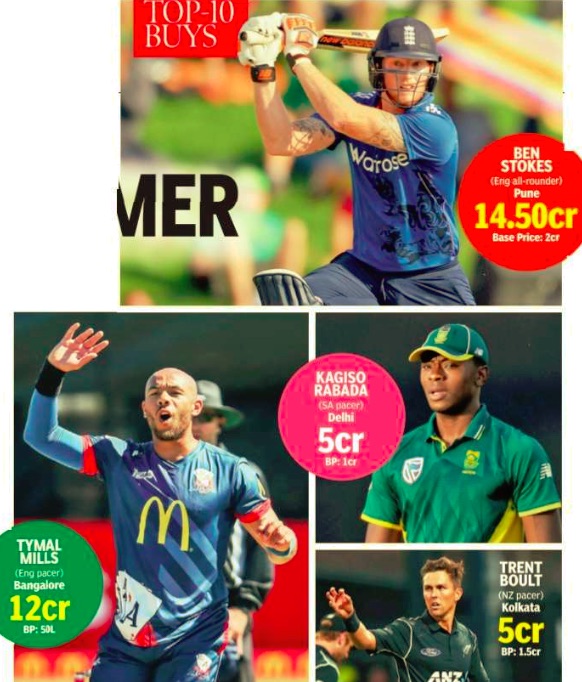


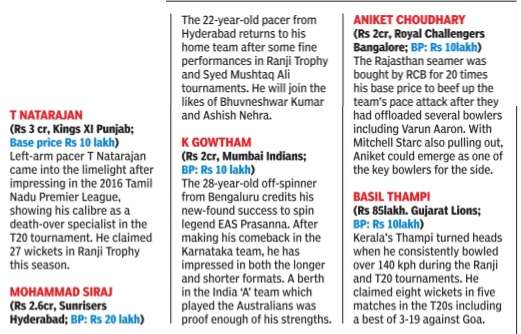
2017/ IPL- 10
See graphic.
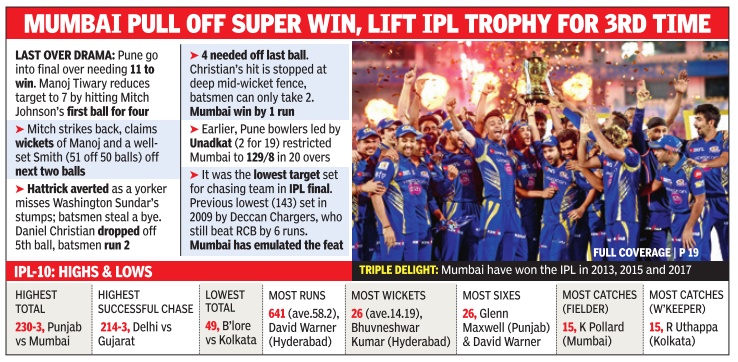
Did high player salaries result in success?
Manuja Veerappa, May 23, 2017: The Times of India
See graphic

IPL-10: Some Investments Went Down The Drain Although A Few Teams Used Their Big Buys Well
If Tymal Mills' IPL performance is measured by his bid price, then each of the five wickets he claimed for Royal Challengers Bangalore came with a mindboggling tag of Rs 2.40 crore! The England pacer, who at Rs 12 crore was the second costliest player at IPL-10, did not do anything extraordinary in the five appearances he made for his franchise.
A T20 specialist, Mills was among the 21 players who hit pay dirt after being picked for a crore or more at the auction held in February . While Ben Stokes (Rising Pune Supergiant) was the costliest at Rs 14.5 crore, others like M Ashwin (Delhi Daredevils), Dan Christian (Rising Pune Supergiant) and Pawan Negi (RCB) earned Rs 1 crore each at the auction.While a few justified their price tags, some disappointed, while the others returned home after being benched through the season.
Stokes and Christian were Pune's main picks at the auction and wise ones at that.Stokes was at the heart of Pune's campaign in the 12 matches he played before joining the England team. Electric and quick as a fielder, the all-rounder claimed 12 wickets at an average of 26.33 and scored 316 runs including an unbeaten century (103 n.o.). His presence in the Pune dressing room turned out to be invaluable for the team. Likewise, Christian with 11 wickets from 13 matches didn't do badly either.
Apart from Pune, the teams for whom investment in crorepati players turned out to be profitable were Kolkata Knight Riders, Mumbai Indians and Sunrisers Hyderabad.
The pace trio of Trent Boult (Rs 5cr), Chris Woakes (Rs 4.2cr) and Nathan Coulter-Nile (Rs 3.5cr) was Kolkata's top buys of the season.While Boult wasn't in peak form, Woakes turned out to be the bowling trump card for Kolkata, picking up 17 wickets in 13 matches.Coulter-Nile too fared well with 15 wickets from eight outings including his three-for in the Eliminator against Hyderabad.
Afghan spinner Rashid Khan and pacer M Siraj didn't disappoint Hyderabad. A Rs 2-crore investment in veteran Aussie pacer Mitchell Johnson proved to be a game-changer for Mumbai, who were also rewarded for their faith in Karn Sharma (Rs 3.2cr), who saw them through to the final with his tidy bowling. In contrast, Karnataka's spin bowler K Gowtham, who created a buzz after attracting a Rs 2-crore bid, didn't get to play even a game for Mumbai.
